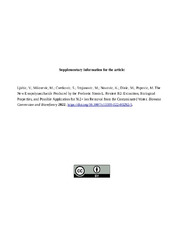Приказ основних података о документу
Supplementary information for the article: Ljubic, V.; Milosevic, M.; Cvetkovic, S.; Stojanovic, M.; Novovic, K.; Dinic, M.; Popovic, M. The New Exopolysaccharide Produced by the Probiotic Strain L. Reuteri B2: Extraction, Biological Properties, and Possible Application for Ni2+ Ion Removal from the Contaminated Water. Biomass Conversion and Biorefinery 2022. https://doi.org/10.1007/s13399-022-03292-5.
| dc.creator | Ljubić, Verica | |
| dc.creator | Milošević, Milena | |
| dc.creator | Cvetković, Slobodan | |
| dc.creator | Stojanović, Marijana | |
| dc.creator | Novović, Katarina | |
| dc.creator | Dinić, Miroslav | |
| dc.creator | Popović, Mina | |
| dc.date.accessioned | 2023-09-05T11:52:38Z | |
| dc.date.available | 2023-09-05T11:52:38Z | |
| dc.date.issued | 2022 | |
| dc.identifier.issn | 2190-6823 | |
| dc.identifier.uri | http://intor.torlakinstitut.com/handle/123456789/644 | |
| dc.description.abstract | Using the universal primers (UNI16Sfw and UNI16Srev) [1], the representative isolates were identified by 16S rDNA sequencing. Amplification was carried out in a thermal cycler (Applied Biosystems, ThermoFisher Scientific) and DNA fragments were amplified as follows: initial denaturation at 94 °C for 5 min, followed by 30 cycles consisting of denaturation at 94 °C for 1 min, annealing at 55°C for 1 min, and polymerization at 72°C for 1 min, and a final extension at 72°C for 7 min. The expected length was 1549 bp. Aliquots (5 µl) of the amplified products were subjected to electrophoresis in 1% agarose gel (ThermoFisher Scientific) in TAE buffer (40 mM Tris acetate, 1 mM EDTA, pH 8.2). Gels were stained with ethidium bromide (500 ng/mL) and visualized under UV light (BioDoc Analyze). All amplicons were eluted and purified using GeneJet PCR Purification Kit (ThermoScientific) by following the manufacturer`s protocol. The PCR products that we obtained were sequenced by the Macrogen Sequencing Service (Macrogen, Amsterdam, The Netherlands) and analyzed by using BLAST algorithm (http://www.ncbi.nlm.nih.gov/index.html). Selected isolates were identified as follows: isolate B2 - Lacotbacillus reuteri, isolate H10 - Lactobacillus murinus, and isolate J7 - Klebsiella oxytoca [2]. The most numerous colonies belong to isolate B2, hence it was chosen for further characterization as a potential source for exopolysaccharide (EPS) production. | sr |
| dc.language.iso | en | sr |
| dc.publisher | Springer | sr |
| dc.relation | info:eu-repo/grantAgreement/MESTD/inst-2020/200026/RS// | sr |
| dc.relation.isreferencedby | https://doi.org/10.1007/s13399-022-03292-5 | |
| dc.relation.isreferencedby | https://intor.torlakinstitut.com/handle/123456789/631 | |
| dc.rights | openAccess | sr |
| dc.rights.uri | https://creativecommons.org/licenses/by/4.0/ | |
| dc.source | Biomass Conversion and Biorefinery | sr |
| dc.subject | Exopolysaccharide | sr |
| dc.subject | L. reuteri B2 | sr |
| dc.subject | Biosorbent | sr |
| dc.subject | Ni2+ ion sorption | sr |
| dc.subject | Adsorption capacity | sr |
| dc.title | Supplementary information for the article: Ljubic, V.; Milosevic, M.; Cvetkovic, S.; Stojanovic, M.; Novovic, K.; Dinic, M.; Popovic, M. The New Exopolysaccharide Produced by the Probiotic Strain L. Reuteri B2: Extraction, Biological Properties, and Possible Application for Ni2+ Ion Removal from the Contaminated Water. Biomass Conversion and Biorefinery 2022. https://doi.org/10.1007/s13399-022-03292-5. | sr |
| dc.type | dataset | sr |
| dc.rights.license | BY | sr |
| dc.description.other | Related to the published version: [https://intor.torlakinstitut.com/handle/123456789/631] | |
| dc.description.other | Supplementary material for: [https://doi.org/10.1007/s13399-022-03292-5] | |
| dc.identifier.fulltext | http://intor.torlakinstitut.com/bitstream/id/1373/The_new_exopolysaccharide_supp_2022.pdf | |
| dc.identifier.rcub | https://hdl.handle.net/21.15107/rcub_intor_644 | |
| dc.type.version | publishedVersion | sr |

